Although Samurai Spy (Ibun sarutobi sasuke, Shochiku, 1965) from a novel by Yoshiyuki Fukuda is not at the high end of samurai film classics, nor is it one of Masahiro Shinoda's best films. But it is a fine film in its own smaller right, beautifully designed & photographed in widescreen black & white.
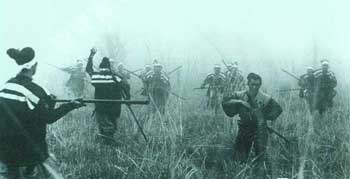 Sasuke Sarutobi (played by the elegantly handsome Koji Takahashi, who looks almost caucasion with his sharp nose so much longer than most Japanese people) wanders the countryside gathering information for his Lord Sanada. His lord is of a small clan undecided whether to side with the Tokugawa clan or Toyotomi clan in what could result in civil war. Until Sasuke's lord's will is known, he is supposed to remain independent of either faction, even while keeping his lord apprised of both sides' dolings. Sasuke Sarutobi (played by the elegantly handsome Koji Takahashi, who looks almost caucasion with his sharp nose so much longer than most Japanese people) wanders the countryside gathering information for his Lord Sanada. His lord is of a small clan undecided whether to side with the Tokugawa clan or Toyotomi clan in what could result in civil war. Until Sasuke's lord's will is known, he is supposed to remain independent of either faction, even while keeping his lord apprised of both sides' dolings.
The countryside is crawling with ninja spies for both factions. They resent Sasuke's fence-sitting position & are tempted to kill him for spying equally against both sides. But the Tokugawa faction helps him stay alive because they believe he has independent information useful to them, or he may influence his lord to choose the side of the Tokugawas.
 Director Masahiro Shinoda believed this functioned as a parable for the cold war between Russia & America in the 1960s, though the story's simplicity is too universal for just that, & doesn't really beg for any deeper political meaning. However, in Daiei's defining Shinobi no mono ninja series which began in 1962, political intrigue & the ambiguity of right & wrong was integral to a film noir cynicism, so Shinoda was not expecting anything particularly novel. Director Masahiro Shinoda believed this functioned as a parable for the cold war between Russia & America in the 1960s, though the story's simplicity is too universal for just that, & doesn't really beg for any deeper political meaning. However, in Daiei's defining Shinobi no mono ninja series which began in 1962, political intrigue & the ambiguity of right & wrong was integral to a film noir cynicism, so Shinoda was not expecting anything particularly novel.
The story though not great is sufficient to sustain interest, & the ninja & samurai action is gorgeously choreographed. Tetsura Tamba plays the head of the Yagyu spy network, dressed in the white garments of a monk. He's a powerful sly figure who is simultaneously a threat & an assistance to our hero.
The choice of white for the head ninja goes against the usual black costuming for such shadowy figures. Shinoda's instructions from the Shochiku studio was to keep his films bright. Shochiku at that time felt that the upbeat well-lit sunniness of the majority of their films set them apart from Toho & Daiei where gloom & shadowiness were the norm. Yet Shinoda wanted to make a film noir, & searched his artist's heart for a method around Shochiku's preference for films that were pictorially sunny.
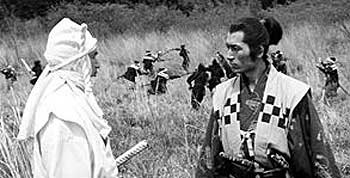 He hit upon a stylistic balance with some scenes very shadowy in the tradition of ninja films up to that time, but other scenes taking place in such thick white mist that during the climactic duels, the entire screen turns completely white, ninja & samurai vanishing in & out of the whiteness. The Yagyu white costume was a foreshadowing of the film's use of white on white to sustain a kind of reverse-shadow gloominess. Even at that, the best sequenes for lighting are those for which darkness & shadow, streaked with light, provide truly brilliant pictorial moments. He hit upon a stylistic balance with some scenes very shadowy in the tradition of ninja films up to that time, but other scenes taking place in such thick white mist that during the climactic duels, the entire screen turns completely white, ninja & samurai vanishing in & out of the whiteness. The Yagyu white costume was a foreshadowing of the film's use of white on white to sustain a kind of reverse-shadow gloominess. Even at that, the best sequenes for lighting are those for which darkness & shadow, streaked with light, provide truly brilliant pictorial moments.
Sasuke, who has grown up in an age of peace & sincerely hopes the threat of warfare never fully erupts, not only serves his lord's need for uninvolved intelligence from the field, but is on a personal quest to understand himself, his position, & to learn to his own satisfication if there is such a thing as right & wrong among these factions. He eventually decides there is right & wrong & so cannot help but be involved on the side of good.
This becomes a quest to find Tatewaki (Okada Eiji), an important figure among the Tokugawa ninjas who has reason to defect to the Toyotomi clan. He's a figure who does pretty much symbolize the grey area that is neither all good nor all bad.
A moderate "mystery" as to who is killing people Sasuke encounters (at least one of whom Sasuke feels compelled to avenge), provides sufficient plot, one that is resolved skillfully. But ultimately it is not the plot so much as it is the atmosphere, emotion, light, shadow & action that are important in this physically beautiful film.
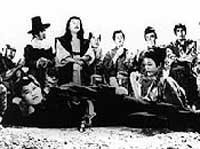 In Sasuke & his Comedians (Sanada Fu-unroku, Toei, 1963) the fanatic Sanada (Yoshito Inaba) pits himself against the Tokugawa clan in the defense of Osaka Castle. Closer to "sword & sorcery" than an historical epic, & impossible to take seriously, the film's very title informs the viewer not to expect the usual dour ninja film. In Sasuke & his Comedians (Sanada Fu-unroku, Toei, 1963) the fanatic Sanada (Yoshito Inaba) pits himself against the Tokugawa clan in the defense of Osaka Castle. Closer to "sword & sorcery" than an historical epic, & impossible to take seriously, the film's very title informs the viewer not to expect the usual dour ninja film.
Among Sanada's magician-spies is the super-ninja Sarutobi Sasuke (Kinnosuke Yorozuya) whose talents include levitation of himself & objects, mind-reading, vanishing at will, & rising out of the ground anywhere he pleases. The origin of his powers, we're informed, was exposure to a radioactive meteorite as an infant.
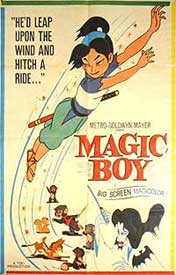 This unlikely character is based on a semi-historical figure who tradition says was born the day a tremendous meteor struck the earth. According to the often-mined legend, Yukimura Sanada was a decisive hero at the end of the Warring States Era, around whom were arrayed a cluster of ten heros, including Sasuke. In Masahiro Shinoda's Samurai Spy reviewed above he is treated as a skillful but realistic figure, but in Ninja Spy (Sarutobi Sasuke, Shochiku, 1966) with Ichiro Zaitsu as Sasuke, he's assumed to be a real sorcerer capable of magic. In Shogun Assassins (Sanada Yukimura no Bouryaku, Toei, 1979), Sanada's jumping-monkey Sasuke is treated as an actual anthropmorphized monkey ninja. This unlikely character is based on a semi-historical figure who tradition says was born the day a tremendous meteor struck the earth. According to the often-mined legend, Yukimura Sanada was a decisive hero at the end of the Warring States Era, around whom were arrayed a cluster of ten heros, including Sasuke. In Masahiro Shinoda's Samurai Spy reviewed above he is treated as a skillful but realistic figure, but in Ninja Spy (Sarutobi Sasuke, Shochiku, 1966) with Ichiro Zaitsu as Sasuke, he's assumed to be a real sorcerer capable of magic. In Shogun Assassins (Sanada Yukimura no Bouryaku, Toei, 1979), Sanada's jumping-monkey Sasuke is treated as an actual anthropmorphized monkey ninja.
 Sasuke is a popular anime, manga & childrens book character. The Disneyesque Shonen Sarutobi Sasuke (Magic Boy aka Adventures of Little Samurai, Toei, 1959) may be where modern anime at feature length should mark its beginnings. The character of Sanada in this cartoon is voiced by the same Kinnosuke Nakamura who is Sasuke in Sasuke & His Comedians. Sasuke is a popular anime, manga & childrens book character. The Disneyesque Shonen Sarutobi Sasuke (Magic Boy aka Adventures of Little Samurai, Toei, 1959) may be where modern anime at feature length should mark its beginnings. The character of Sanada in this cartoon is voiced by the same Kinnosuke Nakamura who is Sasuke in Sasuke & His Comedians.
Sasuke & his Comedians totally refuses to take the character of "Jumping Monkey" Sasuke at all seriously. It is aimed overtly at children & teenagers. It goes so far as to incorporate a rock 'n' roll sequence in which a group of samurai warriors are mesmerized into dancing the Twist in a swamp until they twist themselves into the muck & drown.
All the same, Tai Kato is always an imaginative director, & Kinnosuke invariably a delight on screen. So there are moments of charming conviction even in this campy film. Sasuke's duel up the the side of a waterfall with a Tokugawa magician-spy sparkles with its amusing fantasy swordplay.
Kato was obviously having more fun directing this than Toei Studios intended him to be having, & when the film failed to turn a profit, Kato was nearly fired. He had infused it with satiric moments reflecting youth rebellion, basing this take on a play by Yoshiyuki Fukuda which transposed incidents of student protest from the 1960s to the early 1600s.
copyright © by Paghat the Ratgirl
|
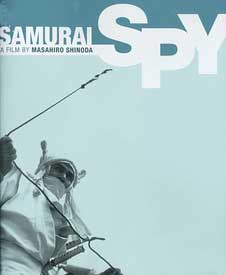
 Sasuke Sarutobi (played by the elegantly handsome Koji Takahashi, who looks almost caucasion with his sharp nose so much longer than most Japanese people) wanders the countryside gathering information for his Lord Sanada. His lord is of a small clan undecided whether to side with the Tokugawa clan or Toyotomi clan in what could result in civil war. Until Sasuke's lord's will is known, he is supposed to remain independent of either faction, even while keeping his lord apprised of both sides' dolings.
Sasuke Sarutobi (played by the elegantly handsome Koji Takahashi, who looks almost caucasion with his sharp nose so much longer than most Japanese people) wanders the countryside gathering information for his Lord Sanada. His lord is of a small clan undecided whether to side with the Tokugawa clan or Toyotomi clan in what could result in civil war. Until Sasuke's lord's will is known, he is supposed to remain independent of either faction, even while keeping his lord apprised of both sides' dolings. Director Masahiro Shinoda believed this functioned as a parable for the cold war between Russia & America in the 1960s, though the story's simplicity is too universal for just that, & doesn't really beg for any deeper political meaning. However, in Daiei's defining Shinobi no mono ninja series which began in 1962, political intrigue & the ambiguity of right & wrong was integral to a film noir cynicism, so Shinoda was not expecting anything particularly novel.
Director Masahiro Shinoda believed this functioned as a parable for the cold war between Russia & America in the 1960s, though the story's simplicity is too universal for just that, & doesn't really beg for any deeper political meaning. However, in Daiei's defining Shinobi no mono ninja series which began in 1962, political intrigue & the ambiguity of right & wrong was integral to a film noir cynicism, so Shinoda was not expecting anything particularly novel. He hit upon a stylistic balance with some scenes very shadowy in the tradition of ninja films up to that time, but other scenes taking place in such thick white mist that during the climactic duels, the entire screen turns completely white, ninja & samurai vanishing in & out of the whiteness. The Yagyu white costume was a foreshadowing of the film's use of white on white to sustain a kind of reverse-shadow gloominess. Even at that, the best sequenes for lighting are those for which darkness & shadow, streaked with light, provide truly brilliant pictorial moments.
He hit upon a stylistic balance with some scenes very shadowy in the tradition of ninja films up to that time, but other scenes taking place in such thick white mist that during the climactic duels, the entire screen turns completely white, ninja & samurai vanishing in & out of the whiteness. The Yagyu white costume was a foreshadowing of the film's use of white on white to sustain a kind of reverse-shadow gloominess. Even at that, the best sequenes for lighting are those for which darkness & shadow, streaked with light, provide truly brilliant pictorial moments.
 This unlikely character is based on a semi-historical figure who tradition says was born the day a tremendous meteor struck the earth. According to the often-mined legend, Yukimura Sanada was a decisive hero at the end of the Warring States Era, around whom were arrayed a cluster of ten heros, including Sasuke. In Masahiro Shinoda's Samurai Spy reviewed above he is treated as a skillful but realistic figure, but in Ninja Spy (Sarutobi Sasuke, Shochiku, 1966) with Ichiro Zaitsu as Sasuke, he's assumed to be a real sorcerer capable of magic. In
This unlikely character is based on a semi-historical figure who tradition says was born the day a tremendous meteor struck the earth. According to the often-mined legend, Yukimura Sanada was a decisive hero at the end of the Warring States Era, around whom were arrayed a cluster of ten heros, including Sasuke. In Masahiro Shinoda's Samurai Spy reviewed above he is treated as a skillful but realistic figure, but in Ninja Spy (Sarutobi Sasuke, Shochiku, 1966) with Ichiro Zaitsu as Sasuke, he's assumed to be a real sorcerer capable of magic. In  Sasuke is a popular anime, manga & childrens book character. The Disneyesque Shonen Sarutobi Sasuke (Magic Boy aka Adventures of Little Samurai, Toei, 1959) may be where modern anime at feature length should mark its beginnings. The character of Sanada in this cartoon is voiced by the same Kinnosuke Nakamura who is Sasuke in Sasuke & His Comedians.
Sasuke is a popular anime, manga & childrens book character. The Disneyesque Shonen Sarutobi Sasuke (Magic Boy aka Adventures of Little Samurai, Toei, 1959) may be where modern anime at feature length should mark its beginnings. The character of Sanada in this cartoon is voiced by the same Kinnosuke Nakamura who is Sasuke in Sasuke & His Comedians.